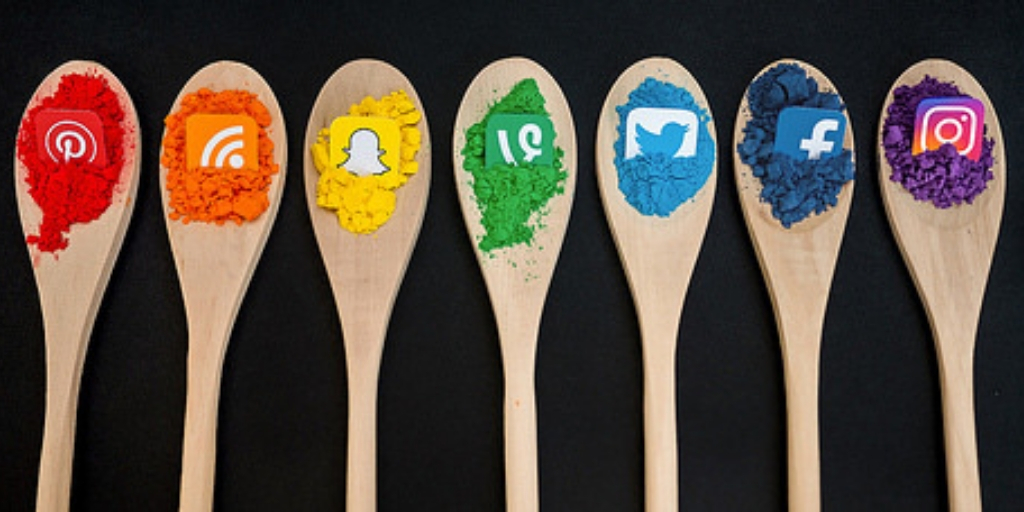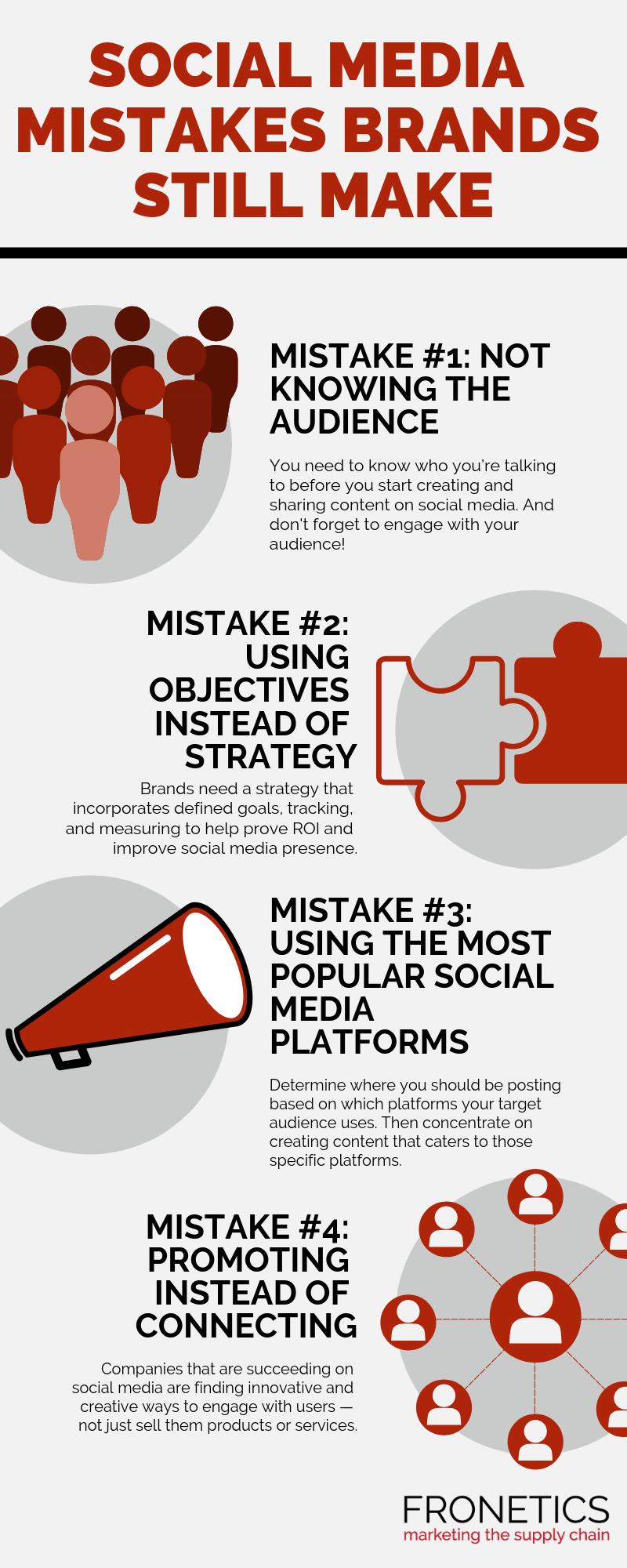
by Fronetics | Mar 8, 2019 | Blog, Marketing, Social Media
Take note: Brands in the supply chain are not immune to these social media mistakes.
Highlights:
- There will be over 3 billion social media users by 2021.
- Not knowing your audience can cripple your efforts.
- Social media is about connecting – not promoting.
Approximately 81% of small and medium businesses use a social platform. And we all understand why. By 2021, it is estimated that there will be around 3.02 billion social media users around the globe. That’s a lot of potential customers.
It’s easy to see why companies are jumping on the social media bandwagon. And there’s no disputing that social mediais an effective way to increase brand awareness and generate leads. But it can be virtually useless if your company isn’t doing it right.
Are you making any social media mistakes? Check out our list of the biggest blunders we see companies making to find out.
4 social media mistakes supply chain brands are still making

(Made with Canva)
Mistake #1: Not knowing the audience
You’d be surprised how often we find that brands don’t have a clear idea of their audience on social media. This covers everything from knowing when followers are active to what content hits home with them to other interests followers might have. You need to know who you’re talking to before you start creating and sharing content on social media.
So how do you figure out your audience? First, it’s important to create a detailed description of your target buyer persona – including location, education level, role in the industry, needs and concerns, and anything else that’s relevant. Next — and we can’t say it enough — engage with your audience! Participate in discussions, encourage comments, and pay attention to what your followers are telling you.
Mistake #2: Using objectives instead of strategy
Social media platforms are continually making changes and updates to improve the user experience. In order to weather these changes and keep your audience engaged, it’s imperative to have a clear strategy that includes types of content, frequency, and pillar topics. Posts should reflect your brand, so make sure posts follow style guidelines and reflect your specific tone.
A strategy will also help achieve ROI. Social Media Examiner’s 2018 Social Media Marketing Industry Report found that only 44% of marketers agree that they know how to measure social media ROI. That means two-thirds of marketers don’t know whether or how much their marketing efforts are paying off when it comes to the use of social media. A strategy that incorporates defined goals, tracking, and measuring will help prove ROI and improve your social media presence.
Mistake #3: Using the most popular social media platforms
Not all social media platforms are created equal. In fact, all social media channels have a differentiating quality that makes them appealing to specific audiences.
Start by identifying where your target audience is spending their time. For example, 81% of millennials view their Twitter account on a daily basis. If your company is looking to capture millennials as leads, your social media efforts should certainly include Twitter.
Once you’ve determined where you should be posting, concentrate on creating content that caters to those specific platforms. Lots of companies post the same content across all of the apps they use. We understand how easy that is for marketers, especially with automation tools. But the foundation of social engagement is authenticity, something that is hard to achieve when posts are the same across all channels. Work to create content — including video and images — that caters to specific platforms to build brand awareness and loyalty.
Mistake #4: Promoting instead of connecting
This one may be the cardinal sin of social media. These platforms are all about engagement. Users don’t want to engage with brands that are pushing their products and services. Users want informative, interesting, and, yes, even fun content. Companies need to focus on creating content that leaves their users wanting more.
[bctt tweet=”Users don’t want to engage with brands that are pushing their products and services. Users want informative, interesting, and, yes, even fun content. ” username=”Fronetics”]
Companies that are succeeding on social media are finding innovative and creative ways to relate to users. When you engage and get users involved in your story, you create long-lasting customer relationships. Storytelling creates an emotional bond with your company and drives brand loyalty.
Greg Hadden, executive creative director of Motive Made Studios, sums up the power of connecting with users: “What often gets lost is the fact that good storytelling is potent stuff. It has the power to make people want to believe and to belong, which is the goal of all storytellers. We’re all selling something, be it an idea, an exploration of the human condition, or say, a vacuum cleaner. It’s no mistake perhaps that good stories often create products.”
What social media mistakes do you try and avoid?
Related posts:


by Fronetics | Mar 1, 2019 | Blog, Current Events, Marketing, Social Media
Also this month in social media news: YouTube has reached nearly 2 billion monthly users; Instagram is developing a feature to simplify multiple account management; and YouTube addresses “dislike mobs.”
Highlights:
- Social media platforms including Facebook, Instagram, and LinkedIn are working to streamline their platforms.
- YouTube usage continues to grow, as the platform begins addressing dislike mobs.
- Good news for businesses: streamlined platforms mean less busy-work for marketers.
This month in social media news, we’re seeing multiple platforms working to integrate and streamline their services. Facebook is merging its messaging platforms, while Instagram (owned by Facebook) looks to simplify multiple account management. Additionally, a major part of LinkedIn’s upgrade to its recruitment tools involves integrating them into a single platform.
Social media usage continues to grow, and YouTube is no exception, announcing that it reached nearly two billion monthly users in the fourth quarter of 2018. The platform is also seeking to address one of the main concerns that users currently face: “dislike mobs.”
The developments this month are important for businesses to be watching. Facebook’s plans to integrate its messaging will no doubt mean changes to current chatbot optionsand possibly open up new opportunities for enhanced marketing automation. LinkedIn’s updated recruiter platforms are welcome news for businesses when it comes to identifying and hiring qualified candidates. And if Instagram’s developments pan out as anticipated, marketers will have an easier time managing multiple accounts.
Here’s your social media news for February 2019.
Facebook Is Integrating Its Messaging Platforms
Facebook has confirmed that it’s working toward integrating the three messaging platforms that it owns— Facebook Messenger, Instagram, and WhatsApp — with the aim of facilitating cross-platform communication. Integration would allow users to send messaging between apps, which would remain distinct. Not only will users be able to communicate seamlessly across multiple platforms, features and tools available on each platform will become available across all three apps.
[bctt tweet=”Facebook has confirmed that it’s working toward integrating the three messaging platforms that it owns — Facebook Messenger, Instagram, and WhatsApp — with the aim of facilitating cross-platform communication.” username=”Fronetics”]
While the project has a long way to go, with changes not showing up for users until at least 2020, this is big news, and businesses should be keeping an eye on ongoing developments.
LinkedIn Updates Recruiter Platforms
LinkedIn announced this month a major upgrade to its recruitment tools, with the goal of streamlining hiring processes and matching more relevant candidates. From the announcement:
“Recruiters have told us they’re often frustrated by the need to jump from tool to tool. We’ve heard you. So we’ve put all of our core tools — Jobs, Recruiter, and Pipeline Builder — on a single platform. Once you create a project, you will be able to see the results from all your active sourcing channels — search results, job applicants, media leads — under the Talent Pool tab, and you can manage candidates from there.”
Additionally, LinkedIn will be adding new AI sorting tools, aiming to find better suited candidates for recruiters, using previous usage trends as well as platform data and learning from personal interests.
YouTube Reaches 2 Billion Monthly Users
Earlier this month, YouTube’s parent company, Alphabet, announced in its Fourth Quarter and Fiscal Year 2018 Reportthat the video giant has more than 2 billion monthly users. Not only that, the number of channels with more than a million subscribers has almost doubled in 2018. Content creators on YouTube are also making more — the number of creators earning between $10K and $1 million from YouTube AdSense has grown more than 40% compared to a year earlier.
Instagram Is Developing an Account-Linking Feature to Simplify Multiple Account Management
After last month’s launchof a feature allowing users to post to multiple accounts with a single click, Instagram is pushing ahead with its efforts to streamline multiple-account management. It’s now developing a new option that will connect multiple accounts under a single login. The development, first reported by TechCrunch, will give Instagram users a variety of account-management options and allow marketers to cut down busy-work, like setting preferences for multiple accounts over and over.
YouTube Is Asking for Feedback in Addressing “Dislike Mobs”
YouTube is addressing the pernicious issue of so-called “dislike mobs” in a recent issue of Creator Insider, the video platform’s corporate series for creators. The company’s developers are considering multiple options, and while it does so, it is soliciting feedback from creators. Options so far discussed include methods for disabling the downvote button, allowing content creators to set preferences for whether ratings are publicly viewable, or requiring users to provide a reason for downvoting a video.
With its announcement that it is addressing the issue of dislike mobs, YouTube is demonstrating its commitment to content creators on its platform.
Related posts:


by Fronetics | Feb 21, 2019 | Marketing, Packaging, Social Media, Supply Chain
Social media is changing just about everything about the way brands market themselves — including packaging design.
Highlights:
- Packaging is a valuable content channel.
- Brands need to make packaging design decisions with an eye to how they read in thumbnail images.
- Use scalable imagery and optimize form function, color pallet, and font for user-generated social media content.
Social media has had an impact on just about everything in our lives, and the packaging industry is no exception. Have you ever considered that packaging is a form of content? In fact, the packaging design of goods is yet another opportunity for the delivery of branded content that engages buyers with brands.
[bctt tweet=”The packaging design of goods is yet another opportunity for the delivery of branded content that engages buyers with brands.” username=”Fronetics”]
Furthermore, in this environment where the lines between the digital and material worlds are increasingly blurred, savvy marketers are making sure that packaging aligns with online branded content, creating a cohesive consumer experience. As Mark Hewitt of SGK puts it, “By using the pack as media, brands can create a long-term content journey that builds over time.”
These days, social media is one of the biggest influencers in brands’ packaging design, as marketers continue to harness the power of instantly identifiable packaging.
Three ways social media is shaping the packaging industry
The beauty industry is just one example of where social media is revolutionizing the way marketers are conceiving of packaging design. This is an industry where aesthetic appeal has long been a big part of how beauty products were packaged, but brands have shifted their perspective in light of social media’s impact.
Says beauty branding and product design consultant Rinat Aruh, “We used to use the lens of: How do we design to create an impact on shelves? But now, we design for the thumbnail, which really changes some of the choices we make.”
So how are brands adapting their packaging? Paul Nowak, senior director of sales strategy and business development at QuadPackaging, has identified these three key factors.
1) Scalable imagery
We live in a mobile world. Images on social media are overwhelmingly viewed on mobile devices, and it’s crucial for designers to take this into account when making packaging decisions. Designs need to grab attention from the thumbnail, as Aruh alluded to. “This means that before designers finalize the packaging form and the brand design of the creative components, they need to add a step that tests the image on social media platforms and views them on a smartphone, not a desktop,” says Nowak.
2) Form function
Packaging designers have traditionally taken into account form in making design decision. At every phase of the supply chain, it needs to safeguard the product and express the brand and function. But when you put social media into the equation, form decisions take on a new dimension, as many consumer products are exclusively recognizable in social media posts by their packaging.
Nowak uses the example of consumer products like hand lotion. The decision to package the product in “a small tube, a large pump, or an elegant jar all convey different aspects of the brand experience and function of the packaging.”
3) Color pallet and font
As with form function, color and font decisions have always been key factors for packaging design. But these days, decisions about these design elements aren’t about what catches the eye on a shelf or even on a brand website.
Brands need to make decisions about color and font with an eye toward how they play on social media. This often means a simpler approach, making packaging clean and easily identifiable, even from a thumbnail. “Forward-thinking designers will add a social media test in their design phase to assure brand recognition in all media channels,” says Nowak.
What does the future hold?
If we know one thing about social media and how it impacts the marketing landscape, it’s that change is going to be pretty much constant. Brands need to continue approaching packaging as a valuable media channel and an opportunity to engage with consumers.
In addition to optimizing packaging for the user-generated content on social media, we’re seeing a rise of “connected” packaging. From Snap and Facebook codes, savvy marketers are recognizing the power of packaging design as nexus of the digital and material worlds.
Related posts:


by Fronetics | Feb 12, 2019 | Blog, Marketing, Social Media, Supply Chain
Transparency in your supply chain through social media outlets can give a look inside your company in a way that your customers are craving.
Highlights:
- Customers have been demanding more visibility into supply chains of the products they purchase.
- Through social channels like Twitter , LinkedIn , and Facebook, companies are greatly enhancing their two-way communication with customers and sharing information with their stakeholders.
- The top reason that supply chain companies are choosing to participate in social media is to increase the visibility of their company.
Supply chain management is such a complicated web of factors that most companies choose to keep operations behind the scenes and unveil a finished product with an intense marketing roll-out.
But what if that’s backwards and an outdated approach to marketing? (Hint: It is.)
The complexity of supply chain management
There is no question that SCM can be deeply and frustratingly complex. Consider TechTarget’s definition of SCM: “the broad range of activities required to plan, control and execute a product’s flow, from acquiring raw materials and production through distribution to the final customer, in the most streamlined and cost-effective way.”
With so much intense analysis at every step, the details your supply chain management (SCM) team considers can seem endless, and the impressive knowledge they hold is certainly not something most people can understand.
Or can they? What if that mindset – the one that thinks that your SCM is so complex that it wouldn’t interest or be able to be grasped by your customers – is wrong?
In fact, what if it’s so wrong that you are missing something important? Customers today want to understand your supply chain.
Transparency in your supply chain
A common misconception is that most customers are interested in a final product. Of course, your final product better be outstanding, but there are other factors fueling today’s buyers, business-to-business (B2B) customers included.
For a few years now, customers have been demanding more visibility into supply chains of the products they purchase. For example, they want to ensure sustainable practices around the earth’s scarce resources, to know where their food is sourced, and to confirm ethical pay and conditions for any laborers involved. B2B buyers are no exception. They want their vendors to be more than just a final product too, and are constantly searching for value outside the sales funnel.
Transparency with social media
What if you shared what fueled your daily SCM decisions with your customers, stakeholders, and suppliers? Not every last complex detail…but some of them, and the intangibles too:
- What drives SCM decisions besides cost?
- Who is your SC team?
- Where are you sourcing?
- Why do you do things as you do during production?
Transparency of SCM through social media outlets can give a look inside your company in a way that your customers are craving. Through social channels like Twitter , LinkedIn , and Facebook, companies are greatly enhancing their two-way communication with customers and sharing information with their stakeholders.
Of course, the benefits of social media to SCM don’t stop there.The supply chain needs social media for enhanced customer communication, increased industry education, and an ability to socially monitor the market. Social media has the capability to empower your supply chain in multiple ways.
According to a survey we conducted, the top reason that supply chain companies are choosing to participate in social media is to increasing the visibility of their company (95%). Don’t simply focus on your final product(s) and leave out your supply chain! When you make your supply chain transparent to your customers and stakeholders, everyone wins.
This post originally appeared on EBN Online.
Related posts:


by Fronetics | Jan 31, 2019 | Blog, Content Marketing, Current Events, Marketing, Social Media
Also, this month in social media news: Instagram allows posts to multiple accounts; Snapchat shares research on social media use; and YouTube adds new swipe-to-view option.
Highlights
- Facebook and YouTube are making changes that reflect a shift toward the Stories format.
- Snapchat releases research revealing that users seek different types of content on different social media platforms.
- Twitter is considering a big update to its conversational features designed to boost user engagement.
The new year is off and running in the social media world. As social media platforms vie to keep up with user behavior, we’re seeing a broad industry shift in favor of the “Stories” format. Facebook is attempting to ramp up the popularity of its Stories feature by giving users more options for direct response, while YouTube is introducing a swipe option, reflecting the growing preference for this kind of interface.
Businesses should take heed to the changes this month. The opportunity for CTA stickers in Facebook Stories — as well as Twitter’s plans for new conversational features and Instagram’s introduction of a feature allowing users to post across accounts at the same time — have important implications for how B2B businesses market themselves on social media. Additionally, Snapchat has released the results of a study examining how and why people use various social media platforms.
Here’s your social media news for January 2019.
Facebook Adds Call-to-Action Stickers for Page Stories
As Facebook continues to work toward making its version of Stories a success, the social media titan is testing a new set of Call-to-Action (CTA) stickers for Pages. The stickers let businesses on Facebook use Stories more effectively via direct-response tools.
The new buttons echo the CTA options already available to Pages in their header. Options include inviting users to “Shop Now,” “Book,” or “Get Directions” directly from within Stories.
Why does this matter for B2B businesses? This new feature brings direct action to where Facebook is pushing users to spend more and more time — Stories.
Twitter Releases Detailed Plans for Beta Testing of New Conversational Features
Twitter is looking to evolve its platform in line with usage trends, announcing the creation of a new beta program to test its conversational options. According to TechCrunch, Twitter will soon launch the beta program with a select group of users. Features to be tested include color-coded responses, algorithmically sorted replies, and status updates.
If the beta testing is successful and Twitter adopts the changes, expect to see a big impact on platform use. For example, color-coded replies would corollate with your connections, making them easier to locate within extensive threads. Algorithm searching would also assist with keeping users up to date with the most personally relevant parts of any discussion — all with the goal of boosting engagement.
Instagram Now Lets You Post to Multiple Accounts at Once
Earlier this month, Social Media Today and TechCrunch reported that Instagram is rolling out a feature allowing users to post a single update across multiple profiles at the same time. For social media managers responsible for maintaining several accounts, this is big news.
[bctt tweet=” Instagram is rolling out a feature allowing users to post a single update across multiple profiles at the same time. For social media managers responsible for maintaining several accounts, this is big news.” username=”Fronetics”]
It’s now easy to post content to all accounts at once. But the question remains: is this good news for your audience? Of course, every case is different, but it’s yet to be determined if this ease of posting identical content across multiple platforms will broaden audience engagement or backfire, causing users to get bored and tune out your content all together.
Snapchat Shares New Research on How and Why People Use Different Social Media Platforms
Partnering with Murphy Research, Snapchat Business conducted a study of more than 1,000 of its users between the ages of 13 and 44. The goal was to gain insight into the social media apps they use, why they spend time on each, and how each makes them feel.
The research revealed three key insights:
- The apps people use can impact their moods.
- There’s a reason users tap on each app.
- And there’s a time and place for each app in this space.
What does this mean for B2B users? Being aware of the various platforms people use to find a specific type of content, for example, can help shape content creation and sharing.
YouTube Adds a New Option to Swipe to View the Next Video
As if it weren’t easy enough to fall down a YouTube rabbit hole. This month, the video giant is rolling out a new option that gives users the option to swipe left to view the next video or right to go back to the previous. Users can also get a “sneak peek” of the next or previous video by partially swiping. Currently, the update is only available to iOS users and is in line with a broader industry trend toward the swipeable Stories format.
Related posts:











